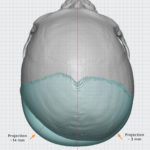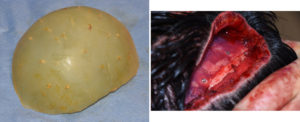Background: The back of the head is prone to a variety of shape deformations. Whether it is from the head position that the fetus lays in utero or how the child sleeps after birth, the early moldability of the skull bones can create less than a round appearance on the back of the head. The exposure to such external deforming forces is greater on the back of the head than any other skull area.
One side being flatter than the other creating asymmetry in occipital projection is the most common aesthetic skull deformity that I see. Men seek treatment for it more commonly than women for the obvious reason that they have. Shorter hairstyles which exposes the back of their head more than women. Women may be aware of their occipital asymmetry but they seek treatment less because of better hair coverage.
The best method for occipital sugmentation, particularly when asymmetry exists, is a custom occipital skull implant. In the 3D planning and implant design process it identifies the differences between the two sides of the back of the head and allows for a precise matching of the two sides in the implant design.The determination needs to made as to whether the more projected side needs to be further augmented or not.


The size of any skull implant can not be limitless. Its design must take into consideration how much the scalp can stretch on an immediate basis. This is usually in the range of 10 to 15mms at the maximal point of projection. If more than this projection is needed a first stage scalp expansion will be needed.
Highlights:
1) Asymmetry of the back of the head is a very common aesthetic skull deformity.
2) Most occipital asymmetries have adequate or near adequate projection on the fuller side
3) A custom occipital skull implant is the most effective method for correcting back of the head asymmetries with the smallest scalp incision in doing so.
Dr. Barry Eppley
Indianapolis, Indiana



